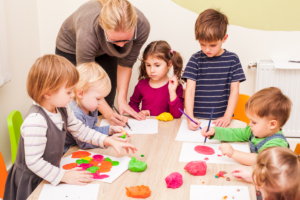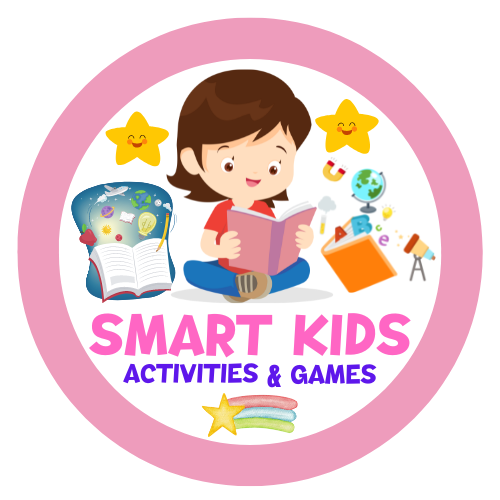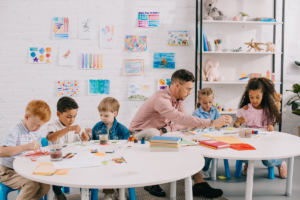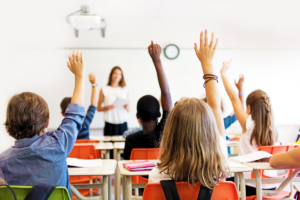Key Takeaways:
- Teacher-student interaction enhances student engagement and academic achievement.
- Effective communication and mutual respect are crucial in fostering positive teacher-student relationships.
- Teacher-student interaction plays a pivotal role in creating a conducive learning environment.
- Addressing individual difficulties and fears through interaction helps students overcome barriers to learning.
- The dynamics of the teacher-student relationship significantly impact students’ overall development.
The Impact of Teacher-Student Interaction on Learning
Teacher-student interaction plays a vital role in shaping students’ learning outcomes. By implementing effective interaction strategies, educators can significantly enhance the learning experience.“Through personalized attention, active listening, and providing constructive feedback, teachers can create a supportive environment that fosters student growth and achievement.”Promoting positive teacher-student interaction has been found to contribute to higher levels of student engagement, motivation, and academic success.
“When teachers establish a positive rapport with their students, it cultivates a sense of belonging and a desire to actively participate in the learning process. This, in turn, improves students’ overall learning outcomes.”In the context of online education, enhancing teacher-student interaction becomes even more crucial to ensure student success and engagement.
“In virtual classrooms, where face-to-face communication is limited, teachers must employ innovative strategies to create meaningful connections with their students. This can be achieved through interactive discussions, collaborative projects, and individualized support.”By implementing effective teacher-student interaction strategies and promoting a positive learning environment, educators can maximize student potential and create a foundation for lifelong learning.
| Benefits of Effective Teacher-Student Interaction |
|---|
| Improved student engagement |
| Enhanced motivation and academic achievement |
| Creation of a supportive learning environment |
| Increased student participation and active learning |
Challenges and Competencies in Teacher-Student Interaction
Establishing a positive teacher-student relationship can be challenging. Teachers face various obstacles and need to be equipped with the right competencies to overcome these challenges. One of the main challenges is understanding and accommodating diverse learning strategies employed by students. Each student has their own unique way of learning, and teachers must be able to tailor their instructional approaches to meet the individual needs of their students. “Effective communication is key in fostering positive relationships.” To foster positive relationships, teachers must develop strong communication competencies. Communication takes many forms in the classroom, including verbal and non-verbal interactions. Teachers need to be proficient in various communication techniques to effectively convey instructional messages and engage students in the learning process. Some essential communication competencies include:- Informative messages: The ability to provide clear and concise information to students, ensuring they understand the content being taught.
- Affective messages: Expressing emotions and empathy, creating a supportive and caring classroom environment where students feel valued.
- Imaginative messages: Utilizing creative strategies to stimulate students’ imagination and critical thinking skills.
- Ritualistic messages: Establishing routines and rituals that promote a sense of structure and consistency in the classroom.
- Persuasive messages: Convincing and motivating students to actively participate and take ownership of their learning.
| Challenges | Competencies |
|---|---|
| Understanding diverse learning strategies | Informative messages |
| Accommodating individual needs | Affective messages |
| Creating an engaging classroom environment | Imaginative messages |
| Promoting structure and consistency | Ritualistic messages |
| Motivating and inspiring students | Persuasive messages |

Dynamics of Teacher-Student Interaction in Language Teaching
In the context of language teaching, the dynamics of teacher-student interaction play a crucial role in facilitating effective learning. By utilizing various strategies, teachers can create a supportive and engaging environment for language development.The Use of Teacher Questions and Student Answers
One important aspect of teacher-student interaction in language teaching is the use of teacher questions and student answers. Through thoughtful questioning techniques, teachers can guide students in their language acquisition journey. By asking open-ended questions, teachers encourage students to think critically and express their ideas. This process not only enhances language proficiency but also fosters cognitive development. On the other hand, student answers provide valuable insights into their comprehension and language production, allowing teachers to adapt their teaching strategies to meet individual needs.Using questions as a pedagogical tool, teachers can promote active engagement, collaborative learning, and the exploration of linguistic nuances. Student answers, in turn, provide opportunities for authentic language practice and allow teachers to assess understanding and provide immediate feedback.
Co-adaptation in Classroom Interaction
Another vital aspect of teacher-student interaction is co-adaptation, where both the teacher and students respond to each other’s cues and adjust their communication accordingly. In language teaching, co-adaptation ensures a dynamic exchange of ideas and promotes shared meaning-making. Through this process, teachers and students co-construct knowledge and develop a deeper understanding of the language being taught. “Co-adaptation in classroom interaction fosters a collaborative environment where students actively participate in the learning process and become co-creators of their language learning experience,” says Dr. Karen Johnson, a renowned linguistics professor.| Benefits of Teacher-Student Interaction in Language Teaching | Strategies for Effective Teacher-Student Interaction |
|---|---|
| 1. Enhanced language development and proficiency | 1. Utilize open-ended questions |
| 2. Increased student engagement and motivation | 2. Provide timely and constructive feedback |
| 3. Improved cognitive skills and critical thinking | 3. Foster collaborative and inclusive classroom discussions |
| 4. Individualized learning experiences | 4. Create a positive and supportive learning environment |
Conclusion
The teacher-student interaction is the cornerstone of a successful education, as it fosters positive relationships and enhances the learning experience. Through effective communication, understanding diverse learning strategies, and mastering communication techniques, teachers can create an enriching and supportive environment for their students. While there may be challenges in establishing and maintaining these relationships, teachers can overcome them by continuously seeking feedback and addressing the individual needs of their students. By doing so, they can ensure that every student feels valued, supported, and motivated to learn. The importance of the teacher-student relationship cannot be overstated. It serves as the foundation for a great education, where students can excel academically, develop their talents, and grow into confident individuals. This relationship becomes a lifelong source of inspiration, as teachers leave a lasting impact on their students’ lives.FAQ
What is teacher-student interaction?
Teacher-student interaction refers to the dynamic relationship and communication between a teacher and their students. It involves effective communication, mutual respect, and shared enthusiasm for teaching and learning. It plays a crucial role in creating a conducive learning environment and addressing individual difficulties that hinder the learning process.
Why is teacher-student interaction important?
Teacher-student interaction is important because it enhances students’ engagement in learning activities and leads to higher academic achievement. It promotes positive relationships, student motivation, and creates a supportive environment for learning. In online education, meaningful teacher-student interaction becomes even more crucial to ensure student success and engagement.
What are effective teacher-student interaction strategies?
Effective teacher-student interaction strategies include personalized attention, active listening, providing constructive feedback, and fostering positive relationships. These strategies enhance the learning experience, promote student engagement, and contribute to higher levels of academic achievement.
How does teacher-student interaction impact learning in online education?
In online education, teacher-student interaction is vital for student success and engagement. It helps create a sense of community and connection, provides personalized support, and ensures clarity in communication. Through effective interaction strategies, teachers can enhance the learning experience and promote student achievement in the online environment.
What are the challenges in teacher-student interaction?
Challenges in teacher-student interaction include understanding diverse learning strategies, accommodating individual needs, and creating an engaging classroom environment. It requires effective communication, adaptability, and continuous feedback to establish and maintain positive relationships.
What communication competencies are important for teacher-student interaction?
Communication competencies such as informative, affective, imaginative, ritualistic, and persuasive instructional messages are crucial for teacher-student interaction. Mastering communication techniques, both verbal and non-verbal, helps teachers create a receptive learning environment and promote clarity in classroom communication.
How does teacher-student interaction impact language teaching?
In language teaching, teacher-student interaction plays a specific importance. The use of teacher questions and student answers serves as a pedagogical and cognitive tool to facilitate language development and understanding. The type of questions asked by the teacher and the quality of student responses impact the level of challenge and engagement in the classroom.
What is the role of co-adaptation in teacher-student interaction during language lessons?
Co-adaptation, where teacher and student respond to each other and influence the learning process, plays a significant role in shared meaning-making during language lessons. It fosters collaboration, interactive learning, and facilitates the development of language skills.
What is the importance of the teacher-student relationship?
The teacher-student relationship serves as the foundation for a great education and a lifelong source of inspiration. Nurturing positive relationships through effective communication, understanding diverse learning strategies, and addressing student needs creates an enriching and supportive environment for learning, leading to higher academic achievement and overall development.
Download free activities and teaching resources Click Here
You may also be interested in
AI in Kids Education: Trends & Benefits
The Importance of Teacher-Student Relationships
Handling Difficult Student Behavior: 10 Tips & Strategies
The Importance of Parent-Teacher Collaboration
Boost Your Brain: 10 Ways to Improve Learning Skills
Exploring Technology’s Role in Education Today
Source Links
- https://www.ncbi.nlm.nih.gov/pmc/articles/PMC3399930/
- https://medium.com/@sumitra_71255/the-crucial-dynamics-of-the-teacher-student-relationship-d355af607132
- https://www.degruyter.com/document/doi/10.1515/iral-2021-0023/html




